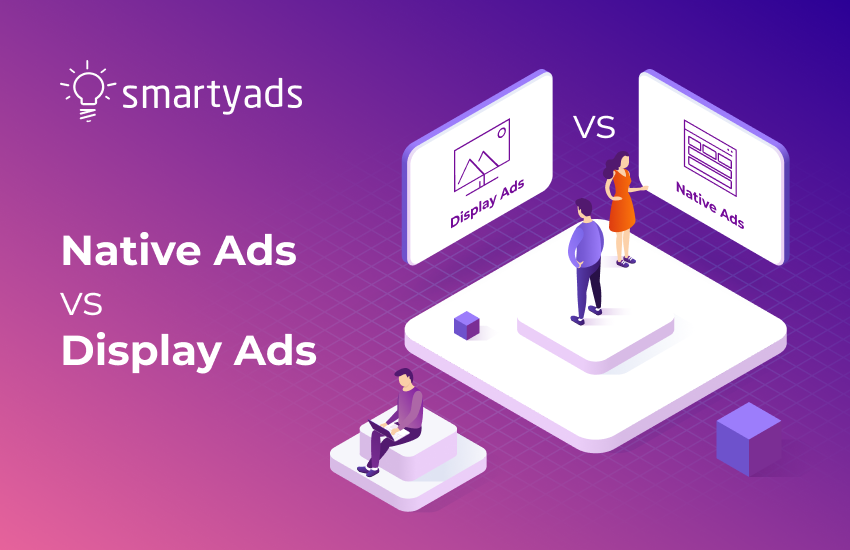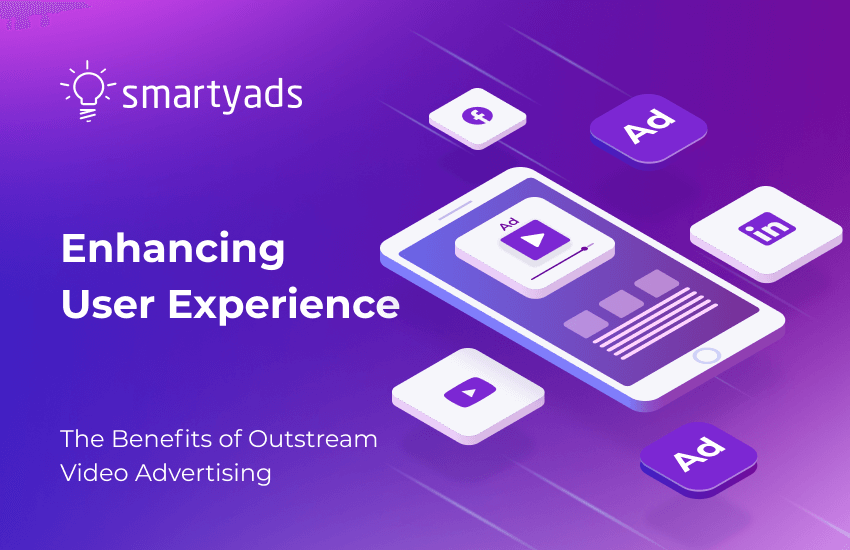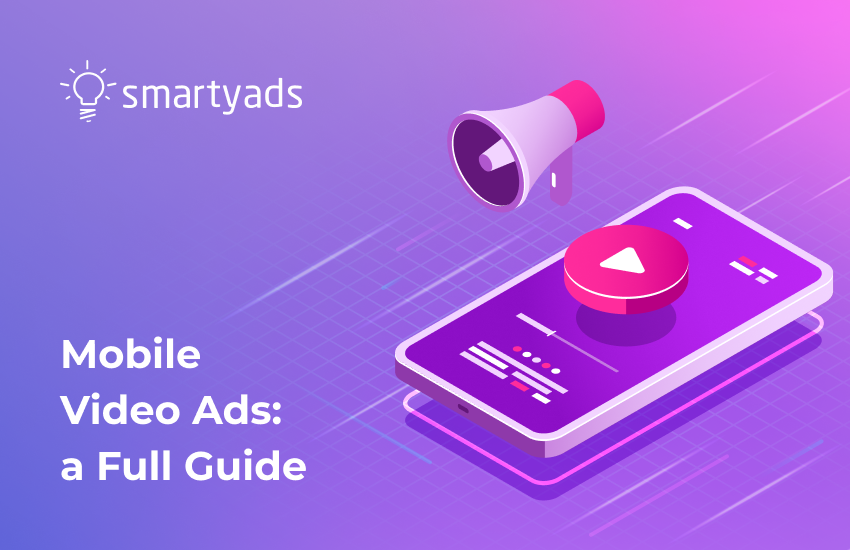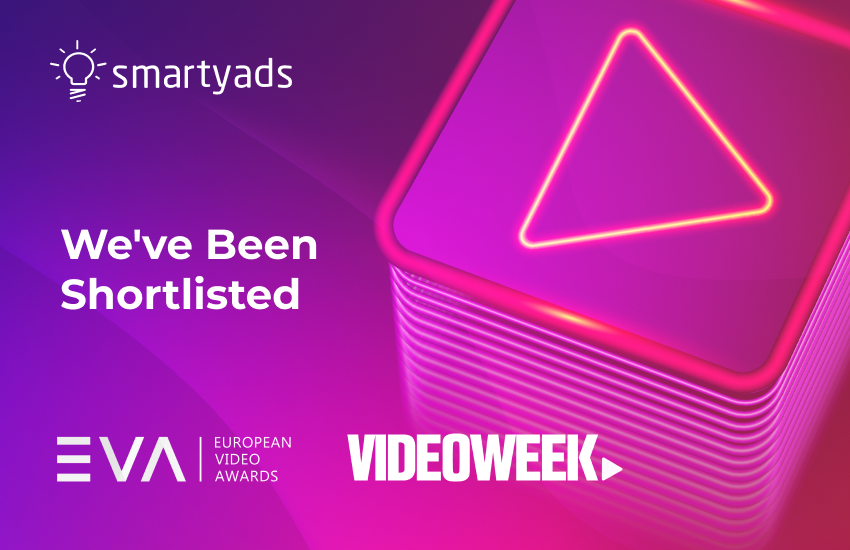The first canonical example of native ad is considered to be the activity of John Deere, owner of the Deere & Company agricultural corporation. He began his magazine The Furrow, which published useful articles about farming and practical tools for it. The target audience was farmers — the main customers of the company. Interestingly enough, both projects, Deere & Company and The Furrow Magazine, have been successfully operating up to the present day.
The world's first display advertising was a banner for AT&T in 1994. 44% of people who saw the media ad clicked on it. The first media ad on the Internet looked like this:

However, in recent years, both native and display ads have made a great leap forward and acquired new forms, formats, and capabilities. Now both media and native ads can be targeted to a specific user, shown at a specific time, and contain interactive elements. All this is due to the development of artificial intelligence and the introduction of machine learning in programmatic advertising technology.
Because of this, it is difficult to answer which type of advertising will be more useful and which one will win in the confrontation: native ads vs. display ads.
Native ads
Native advertising is advertising that demonstrates the value of a product without extolling its benefits with appeals to buy, often perceived by users as a recommendation, so it does not cause rejection.
Native ads can be informational, entertaining, educational materials, how-to guides, or reviews. Everything except blatant advertising in the form of banners or contextual ads. Anything that doesn't openly call for "Buy now, or the discount will burn off" or "Buy 2 T-shirts, get the third one free".
Native advertising in the world of programmatic advertising is built on the same principle: it is masked as much as possible by the content that is presented on a particular page. Sometimes it's so hard to recognize that users don't realize for a long time that they're not watching the video they've turned on YouTube, but the ad.
By the way, advertisers spent $118.72 billion on media advertising in 2021, a 39.4% increase over the previous year. 64.2% of total display ad spending was on native media advertising, including promotional content and feed blocks on social media and news sites.
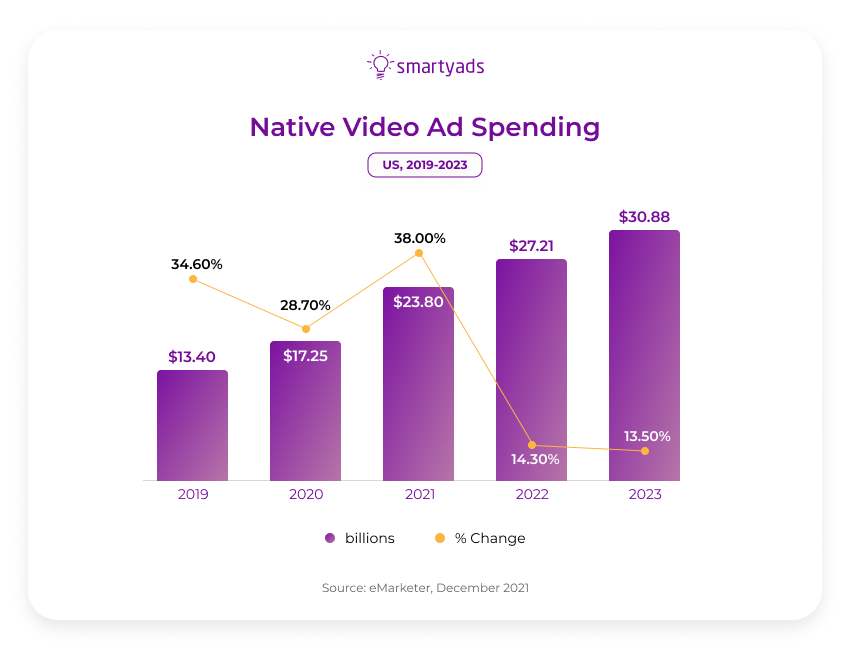
In native ad materials, publications are far from always devoted only to the product to be promoted. Usually, a large part of the publication is a story about some general and useful phenomenon for the user, and only a couple of paragraphs or phrases can talk about the brand that represents this promotional publication.
By the way, do you think this text is part of native advertising or not? We'll answer that at the very end, but for now, let's talk about types of native ads.
Types of native ads
Feed ads
These kinds of native ads usually appear in your social media feed when a brand's account suddenly pops up between the posts of your friends and celebrities you follow. Celebrities and bloggers also create native ads, but they are not programmatic ads.
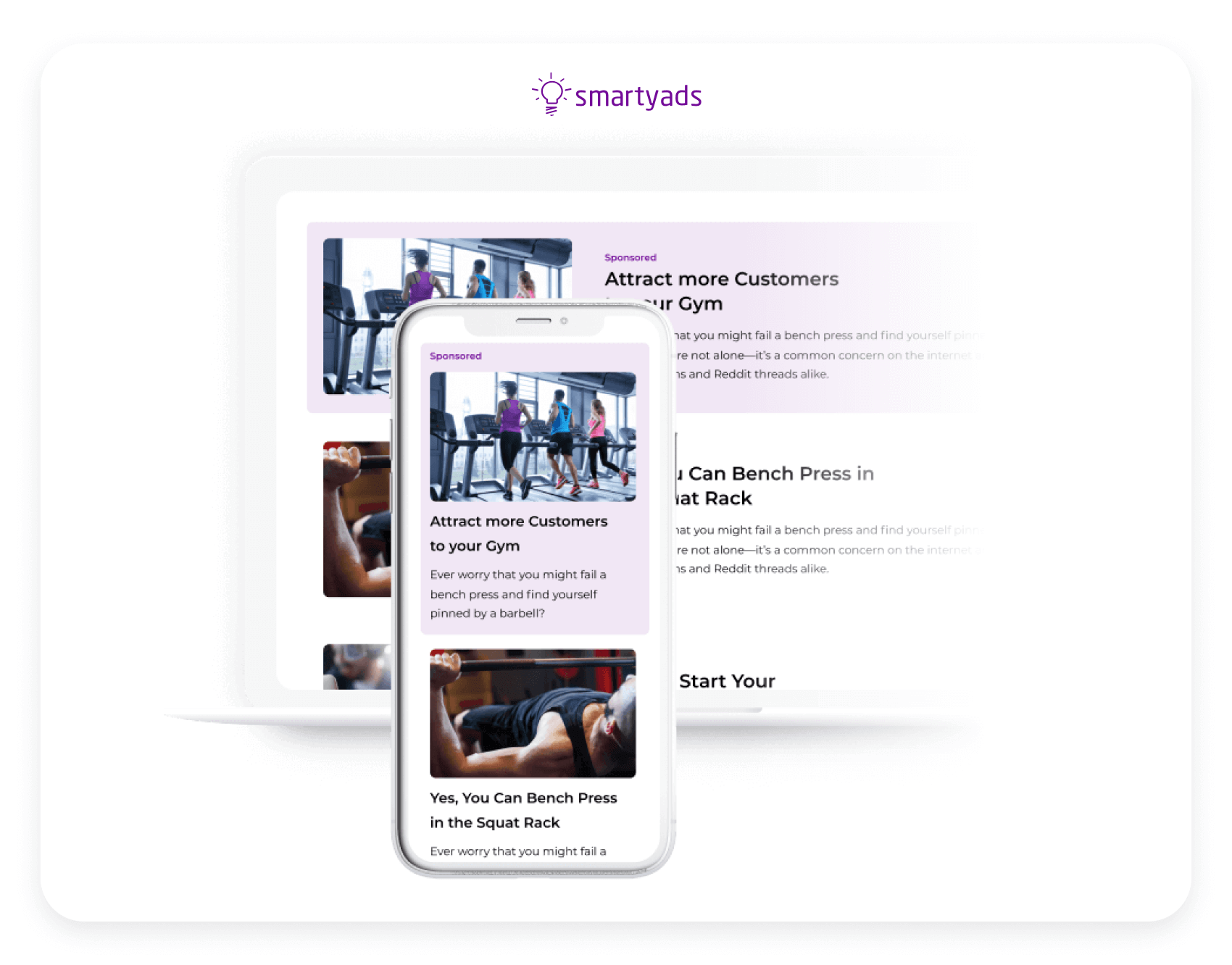
Search and promoted lists
Other common native ad formats are ads that appear at the top of search results for a particular query. Many people don't know that these are ads (try asking your acquaintances who are distant from Internet marketing).
Content Recommendations
These are the blocks that appear under the material you have just read or looked at. For example, under this article would be such a block.
.png)
Programmatic Native Advertising
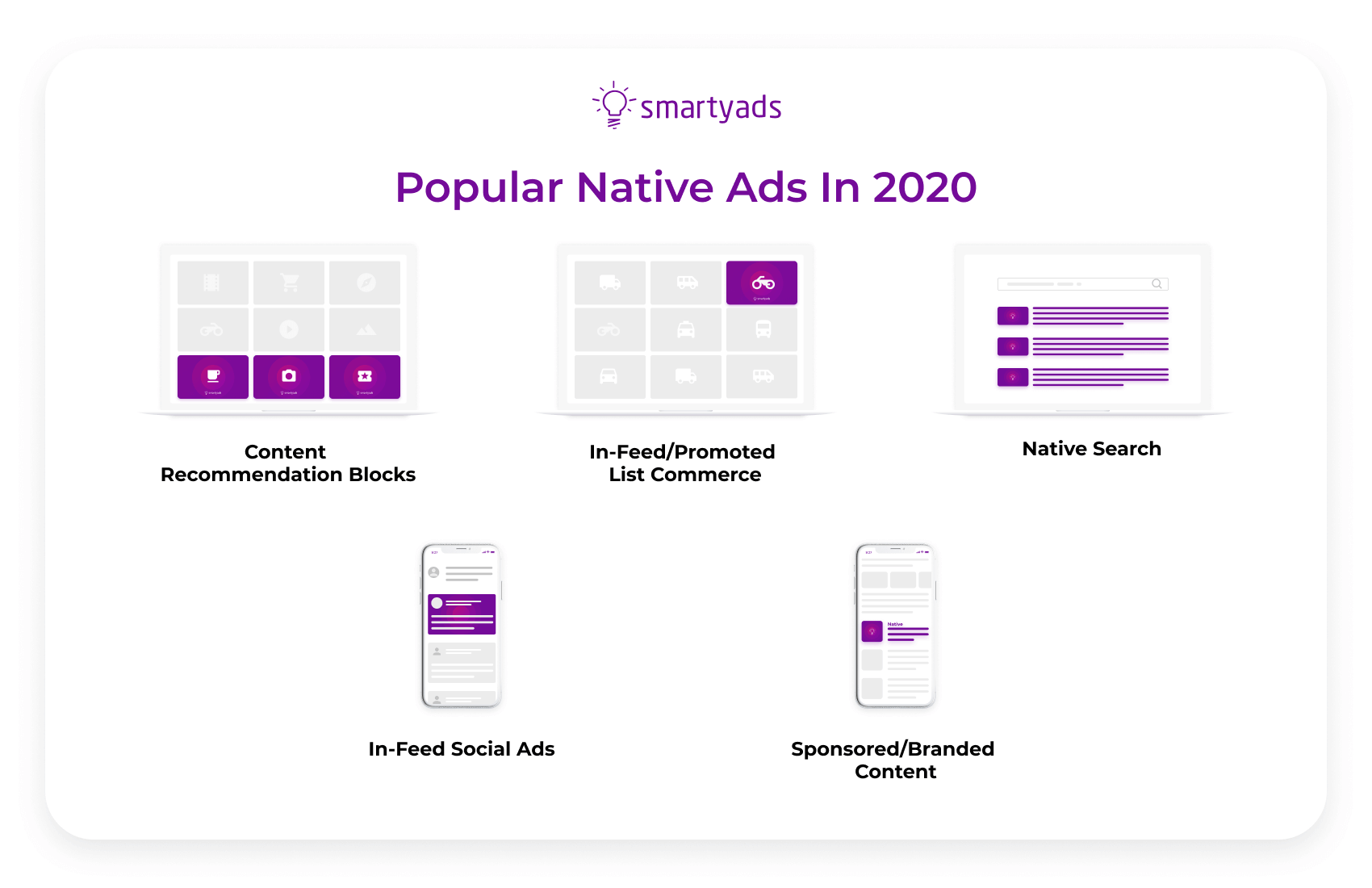
Programmatic native may seem complicated, but it's actually quite simple. Now we will briefly explain how native ad campaigns work. The user goes to the site, creating a place to show ads. The Supply Side Platform (SSP) sends bid requests on the publisher's behalf. The Demand Side Platform (DSP) responds with bids on the advertiser's side.
Based on the auction outcomes, the winning bid is defined and the native ad gets served on the website or app. This entire process happens in a split second.
Native Video Ads
When you combine native ads and video ads, you get a great tool to attract users to your marketing funnel.
Native video ads are shown to users as part of their usual social media news feed. When reading an article or scrolling through a web page, native video ads grab attention by offering relevant, interesting content in a natural and unobtrusive way.
There are other formats of native video ads. For example, view-by-click. This format assumes that the user agrees to view the video. Thanks to it, the advertisement will not interfere with the viewing of web pages irritating unwanted ads. If the user watches such ads, it will mean that they are ready to discover video content and that your advertising offer has interested them.
Display Ads
Display advertising is a type of paid online ad that combines text, images, and a URL that leads to a site where customers can learn more about or buy the company's products. Media-based online advertising is found on websites, apps, and social networks.
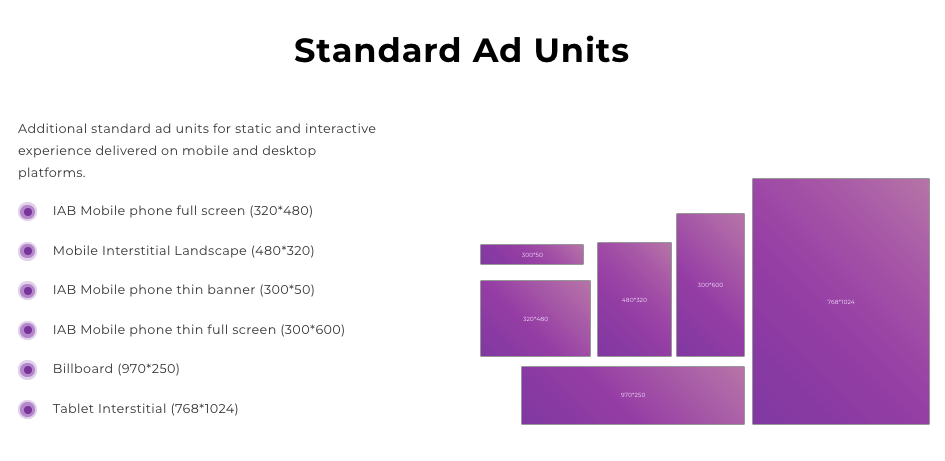
Display Ad formats
Traditional Display Ads
These are online ads that are most associated with media advertising. This display ad is a horizontal, square image, or vertical banner. These media banner ads are basically a graphic element with little text and are mostly placed on websites.
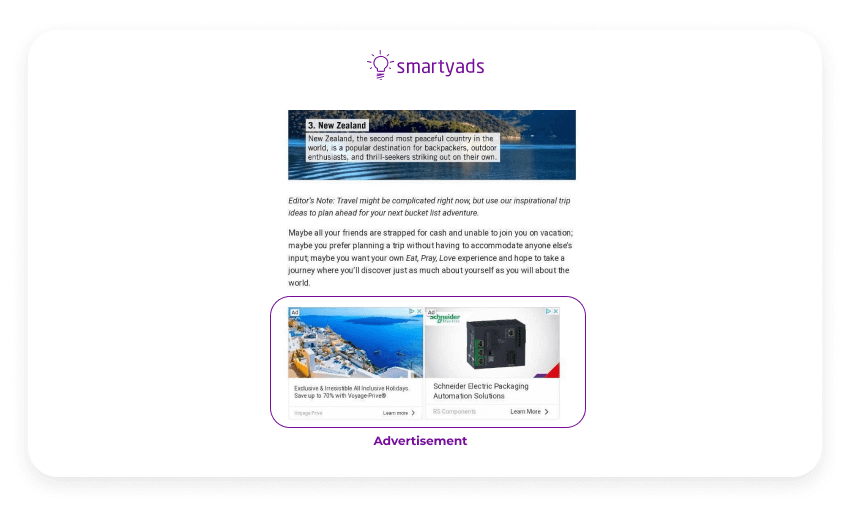
Adaptive Display Ads
This display advertising is based on multiple text headlines, descriptions, and images that the ad platform's algorithm uses to place, size, and orient the ads in various combinations. The platform determines the most effective format for the specified audience.
Display Ads for Retargeting
Retargeting or remarketing is an advertising mechanism that shows banner ads to people who have visited your web resource (usually a specific page or set of pages) within a specified period, but have not yet taken the desired action. Banner ad retargeting is a great tool for personalized content.
Social Display Ads
These are display advertising that you see on social networks such as Facebook or LinkedIn. Like adaptive media advertising, social display ads are a combination of text and images with a call to action.
Discovery Ads
Discovery ads are a form of native digital advertising that uses machine learning to display graphic resources in the most appropriate format for the user. Discovery display ads appear in social media and Gmail ads, in search results on YouTube and Google Discover, and on Watch Next tabs.
Differences between native ads and display ads
Both types of ads can and will be effective, but each is suited to achieve certain goals in advertising. It depends on your marketing strategy. For example, native ads work better for desktop campaigns, while display ads will be more effective on mobile devices.
The difference will be evident in the CTR of your ad campaign: native ads have an average CTR of 0.2% (for premium native ads it's even higher), while display ads have an average CTR of 0.05%. At the same time, native ads will cost more per click.
Below is a comparative table of differences between the two approaches:
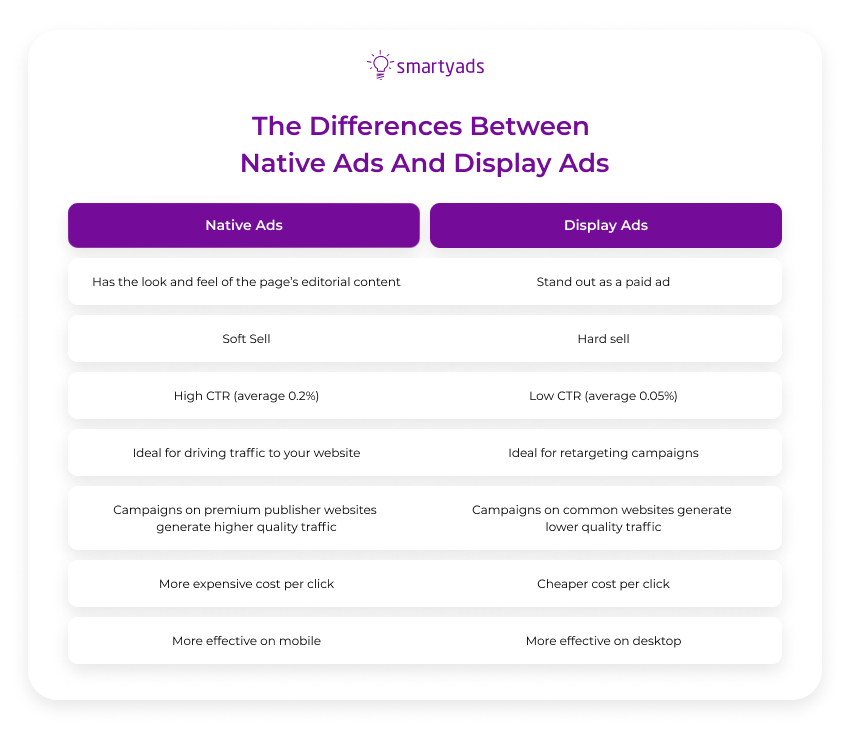
Native ads vs display ads: which ad wins?
None. None of them wins this battle, because native and display ads don't even have to compete. Today, because of the oversaturation of the digital space with ads, many users hate it. That's why the ad-blocking software has more than 500 million downloads.
However, no one benefits from annoying ads, so programmatic advertising, both native and display, is trying to solve this problem by developing new algorithms for interaction with users. Display ads are gradually acquiring the features of native advertising and vice versa. It is possible that in the near future it will be difficult for us to draw a clear line between them.
But so far native and display ads are different branches of the same big tree of programmatic advertising. So when you use them, first of all, you need to think about what goal you want to achieve and what's your marketing strategy. Native advertising is more suitable for some purposes, while display ads are more applicable for others.
In any case, if you want to use any of these types of programmatic advertising, SmartyAds is here to help. Contact us for a consultation.
P.S. Yes, this article is native advertising, because it is on our brand blog and it benefits us to let you know about our services, their quality, and their usefulness.
